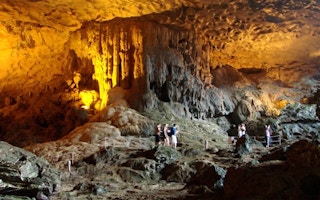As I stood beneath a stalactite in Tien Ong cave in Ha Long Bay, in Vietnam I wondered what stories it could tell about the people who have sheltered within its limestone walls, if it could speak.
It might talk about the people living in the cave thousands of years ago. We know from the archaeological remains that they were eating fresh water seafood, such as molluscs and snails, before the sea began to lap the rocky shores lying a few metres below it.
We know that at some point it was abandoned and then ‘rediscovered’ in 1938 by two European archaeologists. Since then the people inhabiting the floating fishing villages in the area have sheltered there, and in other caves nearby, during storms.
Last year villagers from the Cua Van floating village sheltered within its limestone walls and survived a strong storm, but many of their floating homes, boats and submerged infrastructure used for farming fish, oysters and clams were destroyed.
A project is aiming to improve the community’s disaster risk management strategies so that when the next storm hits, they have a plan in place so they can move people quickly to the cave to wait until the storm breaks. This is only one strand of the project working to develop the community’s resilience to climate change managed by UN Environment Programme and the Vietnam Institute of Fisheries and Economics and Planning (VIFEP) and financed by the GEF Small grants programme and AusAID I visited as part of the 6th International Conference on community-based adaptation to climate change.
The project aims to build resilience in a few ways. It aims to diversify the livelihoods of Cua Van villagers by getting them to benefit from the tourists visiting their village on an almost daily basis. The project is helping support the creation of a village tourism co-operative and providing co-operative members with training and small loans to buy equipment, such as life jackets, so that they can take tourists visiting the village on boat trips or fishing, for example.
Ha Long Bay is a UNESCO World Heritage site. But, as our boat approached the village, I was surprised to see a floating patchwork of garbage on the surface of the ocean. Standing on one of the floating house docks, I could also see small bits of white polystyrene which had broken off from the larger chunks of foam used to keep almost all the houses afloat also floating past. Many of the houses also carry out fish farming, and the fish feed used leads to an accumulation of sedimentation in the water.
The project is aiming to address some of these environmental problems by providing families with loans so that the foam buoys can be replaced with plastic ones, and to provide the skills and loans necessary for them to start otter clam farming. Clams are filter feeders which don’t require feeding, and can play an important role in clarifying the water.
But while the project aims to make the community’s way of living more environmentally sustainable, it faces some big challenges. The project aims to diversify people’s livelihoods by getting them to profit from the tourists visiting their village, but with the current administrative set up, the amounts generated are likely to be small. Fees charged to all tourists when they buy boat tickets to visit the bay through tour operators go to the Ha Long Bay Committee. This group then spends the money to pay for community services benefiting the village, such as garbage collection and children’s schooling. While these are indirect benefits for the village, they don’t see any direct financial benefits from the tourism unless a visiting tourist decides to rent one of their boats, for example. Of the 200,000 tourists that visit the area each year, only 11 per cent visit the village, says Quyen Cao Le, the Vice Director of the Vietnam Institute of Fisheries Economics and Planning (VIFE), and only some of them will be interested in renting boats. “The community don’t benefit sufficiently from the tourism,” she said, “their living conditions are still poor.”
The government is planning to move some or all of the people living in the floating villages to inland areas to reduce the environmental impacts they are having on the area. When we asked about the plans, we were told that they might only move the young and the old, leaving only the men to stay behind and work. But then we were also told later that only the families that moved to the area recently might be moved, so confusion reigns over who is going to be moved and when. But it raises an obvious question: why is a family going to invest long-term in improving their environment if there’s a real threat that they won’t be living there in a few years’ time?
“It’s better to make the area sustainable than to move them,” Quyen said. According to her, the government tried a similar move in 1998 but most people stayed, or moved and then returned. “Most will stay and continue to be the historic owners of the bay,” she said.
Only time will tell whether the community will remain in the bay in 50 or 100 years’ time. If so, will they have become more resilient to the unpredictable storms hitting their community and will have developed more sustainable ways to live within their environment?
The cave stands silent, watching and waiting.
Suzanne Fisher is Web Content Manager at the International Institute for Environment and Development, where this story was originally published.











